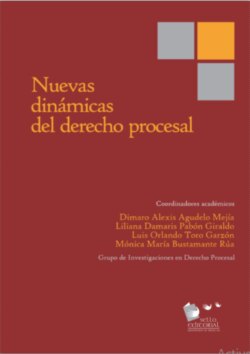Читать книгу Nuevas dinámicas del derecho procesal - Julián García Ramírez - Страница 26
На сайте Литреса книга снята с продажи.
Referencias
ОглавлениеArrabal Platero, P. (2019). La prueba tecnológica: aportación, práctica y valoración. Tirant lo Blanch.
Ashrafian, H. (2014). AIonAI: A Humanitarian Law of Artificial Intelligence and Robotics. Science and Engineering Ethics, 21(1), 29-40.
Barfield, W. y Pagallo, U. (2018). Research Handbook on the Law of Artificial Intelligence.
Beccaria, C. (1769). Tratado de los delitos y de las penas.
Beltrán, J. F. (2007). Los estándares de prueba en el proceso penal español. Cuadernos Electrónicos de Filosofía del Derecho, 15, 1-6.
Bringsjord, S., Bello, P. y Ferrucci, D. (2001). Creativity, the Turing test, and the (better) Lovelace Test. Minds and Machines, 11(1), 3-27.
Citron, D. K. (2007). Technological Due Process. Washington University Law Review, 85(6), 1249-1313.
Ferrer Beltrán, J. (2005a). Prueba y verdad en el derecho (1a ed.). Marcial Pons Ediciones Jurídicas y Sociales.
Ferrer Beltrán, J. (2005b). Prueba y verdad en el derecho (2a ed.). Marcial Pons Ediciones Jurídicas y Sociales, S.A.
Ferrer Beltrán, J. (2007). La valoración racional de la prueba. Marcial Pons.
Foucault, M. (1975). Vigilar y castigar. Siglo XXI Editores.
Gascón Abellán, M. (2005). Sobre la posibilidad de formular estándares de prueba objetivos. Cuadernos de Filosofía del Derecho, 28, 127-139.
Gobierno de España. (1882, 14 de septiembre). Ley de Enjuiciamiento Criminal. BOE 260 https://www.boe.es/buscar/act.php?id=BOE-A-1882-6036
Gómez Orbaneja, E., y Herce Quemada, V. (1972). Derecho Procesal Penal (7a ed.). Artes Gráficas y Ediciones.
González Lagier, D. (2003). Hechos y argumentos (Racionalidad epistemológica y prueba de los hechos en el proceso penal) (I). Jueces Para La Democracia, 46, 17-26. https://dialnet.unirioja.es/servlet/articulo?codigo=409550
González Lagier, D. (2018). Prueba y argumentación (¿Es posible formular un estándar de prueba preciso y objetivo? Algunas dudas desde un enfoque argumentativo de la prueba). Congreso Mundial de Razonamiento Probatorio. Girona.
Günsberg, P. (2019). Some Thoughts on Artificial Intelligence ( AI ). Systems and Responsibility. 24(1), 1-9. https://www.researchgate.net/publication/330825212_Some_Thoughts_on_Artificial_Intelligence_AI_Systems_and_Responsibility
Katyal, S. K. (2019). Private Accountability in the Age of Artificial Intelligence. UCLA Law Review, 54, 56-141. https://pdfs.semanticscholar.org/2c47/5cba8da2947ddcbcfb94c2e036e2fc025b88.pdf
Levendowski, A. (2017). How Copyright Law Can Fix Artificial Intelligence’s Implicit Bias Problem. Washington Law Review, 579-630.
Manzanero, A. L., y González, J. L. (2015). Modelo holístico de evaluación de la prueba testifical (Helpt). Papeles del Psicólogo, 36(2), 125-138. http://www.papelesdelpsicologo.es/pdf/2568.pdf
Manzanero, A. L., y Petisco, J. (2019). Memoria de los testigos y detección del engaño. Delta.
Nieva Fenoll, J. (2010). La valoración de la prueba. Marcial Pons Ediciones Jurídicas y Sociales.
Nieva Fenoll, J. (2016). La razón de ser de la presunción de inocencia. Indret: Revista para el Análisis del Derecho, (1), 12.
Nieva Fenoll, J. (2018a). Inteligencia artificial y proceso judicial. Marcial Pons, Ediciones Jurídicas y Sociales, S.A.
Nieva Fenoll, J. (2018b). Repensando Daubert: La Paradoja de la Prueba Pericial. Civil Procedure Review, 9(1), 11-26. http://www.civilprocedurereview.com/?option=com_content&view=article&id=401
Nissan, E. (2001). The jama legal narrative. Part II: A foray into concepts of improbability. Information and Communications Technology Law, 10(1), 39-52. https://www.academia.edu/27621155/The_Jama_Legal_Narrative_Part_II_A_Foray_into_Concepts_of_Improbability
Nissan, E. (2010). Computer applications for handling legal evidence, police investigation and case argumentation. Springer International Publishing AG.
Nissan, E., y Martino, A. A. (2004). The construction of judicial proof: a challenge for artificial intelligence modelling. Applied Artificial Intelligence, 18(3-4).
Roselli, D., Matthews, J., y Talagala, N. (2019). Managing bias in AI. Companion Proceedings of the 2019 World Wide Web Conference, 10.
Schwab, K. (2016). La cuarta revolución industrial. Editorial Debate.
Taruffo, M. (2002). La prueba de los hechos. Editorial Trotta S.A.
Taruffo, M. (2010). Simplemente la verdad. Marcial Pons, Ediciones Jurídicas y Sociales, S.A.
Tolan, S., Miron, M., Gómez, E., y Castillo, C. (2019). Why machine learning may lead to unfairness: Evidence from risk assessment for juvenile justice in Catalonia. Proceedings of the 17th International Conference on Artificial Intelligence and Law (pp. 83-92). ICAIL. https://chato.cl/papers/miron_tolan_gomez_castillo_2019_machine_learning_risk_assessment_savry.pdf
Tomás y Valiente, F. (1967). Historia del Derecho Penal de la Monarquia absoluta (Siglos XIII a XVIII). Tecnos.
Tomás y Valiente, F. (1987). “In dubio pro reo”, libre apreciación de la prueba y presuncion de inocencia. Revista Española de Derecho Constitucional, (20), 9-34. https://dialnet.unirioja.es/servlet/articulo?codigo=79353
Turing, A. (1950). Computing Machinery and Intelligence. Mind, 59(236), 433-460.
Zubiri, F. (2004). ¿Qué es la sana crítica? La valoración judicial del dictamen experto. Jueces Para La Democracia, 50, 52-62.
